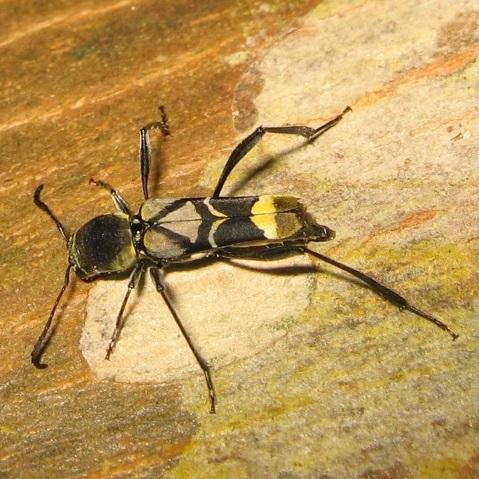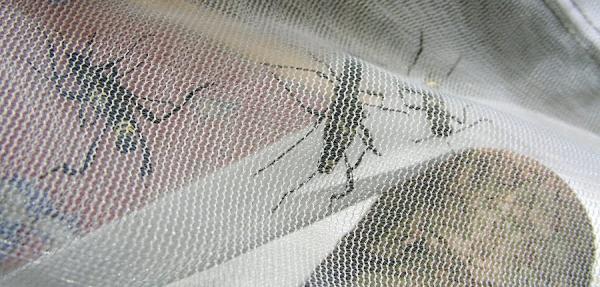

Above: Neoclytus columbianus beetle laying eggs in bark. Below: new adult Neoclytus columbianus attempting to escape mesh bag.
Panama Canal Expansion Creates Rare Opportunity to Obtain Samples in Environmentally Sensitive Area
The widening of the Panama Canal currently underway has created a rare opportunity to study the insects that inhabit the plants of environmentally sensitive Central American rain forest habitats. Dr. Amy Berkov, Professor of Biology at The City College of New York (CCNY), is leading a research effort that could shed new light on biodiversity by documenting the area’s host-plant relationships.
“If you want to study biodiversity and conservation, you need to know what animals eat and where they live, even when those animals are insects,” said Professor Berkov. “For concealed feeders that spend their immature stages feeding within plant tissues, where they live and what they eat are the same…but the insects are not easy to find.”
The canal expansion project, which will raise the level of Lago Gatun, requires trees and other plants on eight headlands or islands that jut into the canal to be cut down. Professor Berkov and her colleague, Dr. Hector Barrios, were able to persuade the Panama Canal Authority and other agencies to permit them to collect samples from a one-hectare plot before the bulldozers began to uproot the trees.
“We’re trying to collect woody species – trees and vines – to find out what wood-boring species inhabit these plants,” she said. “There are not many opportunities to work where a lot of trees are going to be destroyed anyhow.” Dr. Gérard Luc Tavakilian, a French entomologist who worked in French Guiana, conducted the only similar study in the early 1990s, and documented host-plant associations for 347 beetle species.
The beetles of interest to the project spend their larval stages under the bark of the plants. “To get the host-plant association, you can’t just collect adults from plant surfaces, because that won’t tell you where the larvae live,” explained Professor Berkov. “You can’t get this information by collecting larvae either because they are too difficult to identify. However, it is possible to rear adults from wood with intact bark.”
In March, Andreas Hernandez, a botanist from the Smithsonian Tropical Research Institution, located on nearby Barro Colorado Island, identified the trees at the plot. “Tropical plants are very diverse and difficult to identify if they don’t have flowers or fruits,” Professor Berkov noted.
Although she usually works with an arborist who climbs trees to sever bait branches, in Panama field assistants cut down selected trees and then suspended branch sections in the forest canopy along with portable weather meters that measure temperature, humidity, and wind speed. In May the researchers returned to salvage branches with concealed larvae for further study at a lab set up in Gamboa, a short boat trip from the site.
Professor Berkov developed a protocol for gathering and studying branches that allows for comparisons among different plant specimens, and with plants at other research sites. For each tree, the researchers collected the branch section suspended in the canopy, along with three thick branch sections and six smaller branch sections from the cut tree on the ground.
The samples were placed in mesh bags before they were brought to the lab to observe the emergence of beetle species. They are kept in approximately 200 cages – three cages for each of the 60-plus trees that provided samples; one for the canopy branch, one for the thick branch sections and one for the thin branches.
Dr. Sara Pinzón-Navarro, who recently earned her PhD at Imperial College in London, is leading the fieldwork. Joyce Fassenber, a PhD student at CCNY, is assisting her.
Two months after the trees were cut down the first adult beetles emerged. This was much faster than in Professor Berkov’s previous studies in French Guiana and Peru, where the first adults emerged after four to seven months.
Professor Berkov said further research would be needed to explain why the beetles emerged so quickly in this study. Usually wood-feeders have relatively long life cycles because wood is low in nutrients and difficult to digest.
In this case, the host plants may have had an unusually high nutritional content or “the species are incredible assimilators,” she explained. When the trees were cut, Panama was experiencing hot and dry weather, she noted, and this may have speeded up beetle life cycles.
The caged branches produced more than 30 different beetle species within the first month, and continue to produce additional species. Most species have not yet been identified, but so far plant-host associations appear to be consistent with those of the earlier study in French Guiana.
“Beetles are the first insects to visit fallen trees. Thus they are the first colonists in a nutrient cycle that is a tremendous component of the natural world,” Professor Berkov said. “They start the process of converting wood biomass to animal biomass.”
Data stored by the portable weather meters will be analyzed to determine how microclimate on the ground and in the canopy affects wood condition and beetle colonization. Experts on climate change think that some tropical rain forests are likely to become both hotter and drier in the near future. By documenting the microclimate preferences of these ecologically important beetles, it may be possible to predict how they will respond to rapidly changing conditions.
MEDIA CONTACT
Ellis Simon
p: 212.650.6460
e:
esimon@ccny.cuny.edu